Here’s another round-up of the development work on Numbas in the past month-and-a-bit.
A little attribution
I’ve added a small attribution footer to the bottom of the default theme. It looks like this:

Now that people can upload their own themes, we wanted an unobtrusive way of noting that tests are built using Numbas. If you don’t want it there, you can use a modified theme to remove it, but we’d prefer you kept it. Read the rest
On small screens (tablets and phones, mainly), the default Numbas theme didn’t used to leave much space for the question content.
I’ve spent the past couple of days making the theme responsive, so screens less than 980px wide switch to a more vertical layout. The question menu and pause/end buttons move beneath the content area, and the banner is more vertical too. This means the content area can have the full width of the page. Read the rest
A couple of weeks ago I made it possible to upload your own themes to the editor, so it makes sense to also allow you to upload your own extensions.
Extensions in Numbas can affect any part of the Numbas runtime. Typically, that means adding new functions in JME or javascript (or even a new JME data type) to avoid repeating the same code across several questions.
I’ve written some instructions on how to write an extension, along with a couple of examples, in the Numbas documentation.
Numbas has always had support for themes, allowing you to completely change how exams are displayed. The Numbas editor, however, only supported a static list of themes installed by the server administrator, so most users were stuck with the default themes.
I’ve just released an update to the Numbas editor which allows any user to upload a .zip package of their own theme, which they can then use in any exam. You could use this to do something simple such as show your institution’s logo instead of the Numbas one, or add some CSS rules to tweak the layout of the page.
I’ve written some brief instructions on how to create your own themes, along with a couple of simple examples, in the Numbas documentation.
Development on Numbas continues apace, so I thought it’d be a good idea to start writing about changes in more detail here so they don’t slip by unnoticed. Read the rest
We’ve just released some major new features for Numbas, which means we’ve bumped the version number up to v1.6.
The two big changes are template questions and custom marking scripts. Read the rest
Last week I deployed the new question search and organisation interface to the mathcentre editor. We noticed that the global question database was becoming quite unwieldy now that we have so many users (not complaining!), and finding both your questions and good questions written by others was getting harder. The new interface downplays the big list, instead presenting you with a few different ways in to the most useful parts of the site.
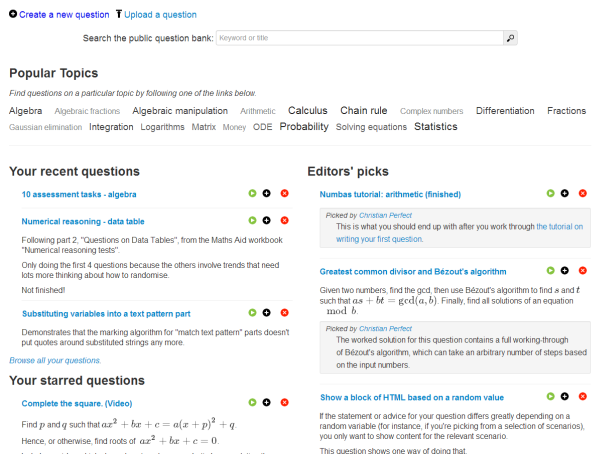
The questions index page now shows you a kind of ‘dashboard’, with links to the most popular tags, your recently-edited questions, as well as some highlights picked by us and your starred questions – you can save a question to this list by clicking on the star next to its name on the question edit page. You can still search the entire database by entering keywords or question titles in the search box at the top of the page.
It’s not a coincidence that we also delivered a workshop on using Numbas at eAssessment Scotland 2013. An hour really wasn’t long enough to do very much at all, but everyone seemed very positive about Numbas and keen to investigate it further. I asked for a show of hands at the start to find out who had signed up for the workshop because they’d already heard of Numbas, and I was pleasantly surprised by the response!
In future conference action, James Denholm-Price of Kingston University London will be giving a talk titled “Using Numbas for formative and summative assessment” at CETL-MSOR 2013 on the 10th of September. James used Numbas in his linear algebra course last year and has many interesting things to say about it. Also at CETL our two summer students, Hayley Bishop and Sarah Jowett, will be talking about their work on the maths support wiki we’re creating with Birmingham University, to complement our respective maths support centres. More on that later!
On the 23rd of October I’ll be giving a talk about Numbas at an IOP-sponsored event on “Promoting learning through technology” at Edinburgh University. I don’t think the event has a webpage or even a definite venue yet; I’ll give details when I have them.
Finally, we’ve set up a numbas-users mailing list on Google Groups. The idea is to have a place to discuss Numbas use, ask and answer questions about authoring, and talk about features you’d like to see. Bill has started it off by asking for comments on the new searching interface.
I’ve just released v1.5 of Numbas on Github. While there have been loads of changes since the last time I remembered to bump the version number up, the biggest change recently is that I have rewritten the default theme to use the knockout.js framework. It makes the underlying code a lot simpler, and allows us to do a few new things that would have been very complicated. In particular, there is now a Review mode which is made available when you have finished an exam – you can click on any question on the feedback page to go back to it and compare your answers with the expected answers, as well as seeing any marking feedback and the model solution in the Advice section.
The version numbers in the Numbas source code repository don’t mean too much since we push updates to the stable branch as soon as they’ve been tested instead of lumping them together, but it’s good to mark progress every now and then.
The mathcentre editor tracks the stable branch, so you can try the new features there now.
The Review mode was something we had in the previous system we used at Newcastle, and it was the one thing that many of the students asked for in a survey conducted at the end of the first semester by Dr. Nick Parker. I’m glad it’s finally in Numbas!
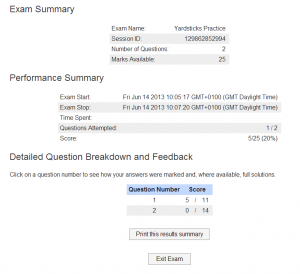
When you finish an exam, you can click on any question to review it.
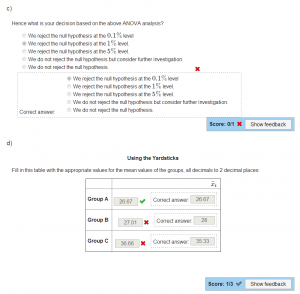
Marking feedback and the correct answers are shown for each part.
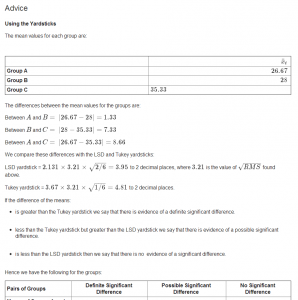
And the model solution given in the Advice section is also revealed.
I’ve just deployed an update to the Numbas editor which makes searching a bit easier, and gives everyone a user profile.
I’ve replaced the old question/exam index pages with a new system which is a lot quicker when the database contains a lot of items (for example, the mathcentre database, which currently contains over 600 questions).

It’s now possible to filter questions by tag, which should make organising and finding questions you’re working on a bit easier. The tags on the question editing page are now clickable, so you can easily find related questions.
Every user has a profile page where they can provide a bio, along with links to their exams, questions, and the tags they’ve used. You can edit your bio by clicking on the “edit your profile” link on your profile page.
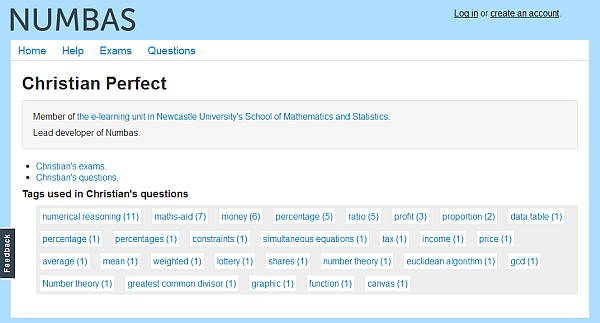
Thanks to Joshua Beals for giving me a prod to sort out the searching interface – it was beginning to creak a bit!
You can try out the new features at the mathcentre Numbas editor.
Many people have asked for the ability to hide questions from public view, and to share editing privileges with their colleagues. I spent last week implementing sharing and access controls on both exams and questions in the Numbas editor.
To define who can see and edit your questions, click on the Access tab on their edit pages. For an explanation of the various settings, see the Numbas documentation.
![]()





